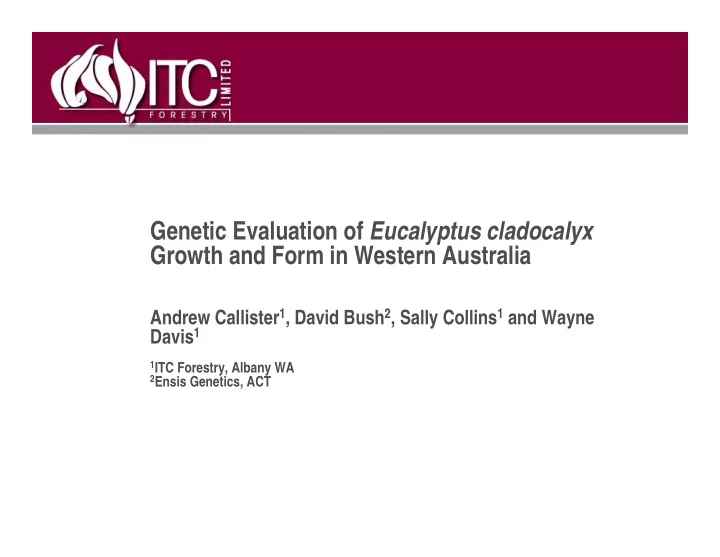

Genetic Evaluation of Eucalyptus cladocalyx Growth and Form in Western Australia Andrew Callister 1 , David Bush 2 , Sally Collins 1 and Wayne Davis 1 1 ITC Forestry, Albany WA 2 Ensis Genetics, ACT
Why Sugar Gum? Sugar gum ( Eucalyptus cladocalyx) • High-value durable timber • Suited to medium-rainfall (400-600 mm) • Tolerates a range of soils • Endemic to South Australia in three disjunct regions
Planted stands Natural distribution
Areas for Improvement Traits of high commercial importance: � Growth rate � Stem straightness � Branch thickness � Apical dominance � Wood properties (???)
ITC Sugar Gum Trials ITC established three sugar gum family trials in 2001 to: � Evaluate the performance of the species in the medium-rainfall zone � Identify superior seed sources � Participate in the ALRTIG improvement program
Seed Origins of Trial Material Region-of- Seed source Selection method Families provenance group S. Flinders Ra. Wirrabara State Forest Random (ex wild) 4 S. Flinders Ra. Wilmington Random (ex wild) 2 S. Flinders Ra. Mt. Remarkable Random (ex wild) 2 Kangaroo Island Flinders Chase National Park Random (ex wild) 7 Kangaroo Island Cygnet River Random (ex wild) 3 Kangaroo Island American River Random (ex wild) 3 Planted Stand Kersbrook SPA Phenotypically 10 selected mother and pollen parents Planted Stand Majorca Phenotypically 5 selected mother Planted Stand Mt. Burr Phenotypically 4 selected mother Planted Stand Lismore Phenotypically 2 selected mother
Genetic Groups Due to the small sample size (42 families) we grouped families according to region-of-provenance � Southern Flinders Ranges (ex-wild) � Kangaroo Island (ex-wild) � Planted Stands (phenotypically selected)
Trial Locations
Site Descriptions Sites have a similar climate: � Hot dry summers, cool wetter winters � Around 500 mm rainfall � 1300 to 1700 mm pan evaporation Kojonup – Duplex (sand over loam) soil for 2m over granite Wellstead – grey deep sandy soil Esperance – yellow deep sandy soil
Trial Assessments Height; 3.5 / 5.5 years DBH; 3.5 / 5.5 years Volume Index; 3.5 / 5.5 years Stem Straightness (1-6); 3.5 years Branch Thickness (1-6); 3.5 years Axis Persistence (1-6); 5.5 years
Statistical Methods ASReml solved mixed model equations: Multivariate � Within-site analyses of multiple traits � Type A genetic correlations � Used to estimate heritabilities Univariate � Single trait analysed across three sites � Type B genetic correlations
Heritability Estimation Narrow sense heritability estimated within region of provenance σ 2 2 . 5 = f 2 h , σ + σ + σ + σ 2 2 2 2 f P B e Variance Components: Family (f), Plot (P), Incomplete Block (B), Error (e) Coefficient of Relationship = 1 / 2.5 to account for inbreeding
Results – Genetic Groups
6 5 RESULTS - Genetic Groups Esperance 4 3 5 Age (years) Wellstead 4 3 5 Kojonup 4 3 11 10 9 8 7 6 0 140 120 100 80 0 70 60 50 40 30 20 10 0 Volume (dm 3 ) Height (m) DBH (mm)
5 4 Branch Size 3 2 Effects of genetic 1 groups on tree form 0 3 Straightness 2 1 Results support 0 5 previous findings Apical Dominance 4 3 2 1 0 P SF KI
Heritability Estimates Kojonup Wellstead Esperance Height 3.5 yr 0.55 (0.12) 0.85 (0.15) 0.78 (0.14) Height 5.5 yr 0.60 (0.13) 0.79 (0.14) 0.58 (0.14) DBH 3.5 yr 0.44 (0.10) 0.43 (0.10) 0.41 (0.10) DBH 5.5 yr 0.42 (0.10) 0.44 (0.10) 0.41 (0.10) Volume 3.5 yr 0.47 (0.11) 0.40 (0.10) 0.43 (0.10) Volume 5.5 yr 0.47 (0.11) 0.42 (0.10) 0.41 (0.10) Branching 0.17 (0.07) 0.03 (0.04) 0.12 (0.06) Stem Straightness 0.16 (0.07) 0.50 (0.11) 0.21 (0.07) Apical Dominance 0.19 (0.07) 0.23 (0.08) 0.21 (0.08)
Inflated h 2 for growth? Our h 2 estimates may be inflated by: � Greater inbreeding than assumed 0.3 � Broad genetic grouping • up to 20% inflation of h 2 compared with precise provenance grouping (David Bush unpublished) � Small number of families • Increases the effect of a few outlying families � NOT GxE, at least across our three sites
Type A Genetic Correlations Genetic correlations between the same trait measured at 3.5 and 5.5 years range from 0.96 to 1.00 Correlations between growth and form traits generally favourable but not statistically significant • Possibly limited by small sample size • Suggests good potential to concurrently improve multiple traits
Type B Genetic Correlations Type B genetic correlations not significantly different to 1.0 for Ht (5.5), DBH, Volume and Stem Straightness • No GxE for these Traits Significant GxE for branch size (common r B = 0.50) Significant GxE for apical dominance involving one pair of sites (r B = 0.78)
Conclusions This study is a first look at the potential to improve sugar gum for commercial plantations
Conclusions Prospects for genetic improvement appear positive � High heritability for key traits � Stable genetic ranking in early growth � No adverse trait-trait correlations � Stability across the southern WA environment
Recommend
More recommend